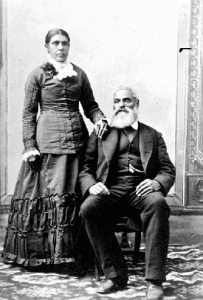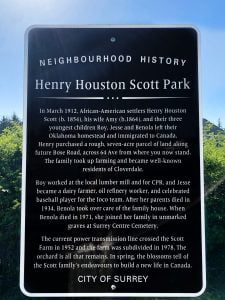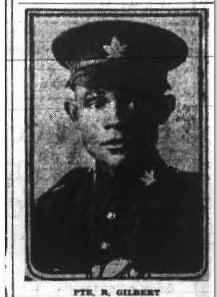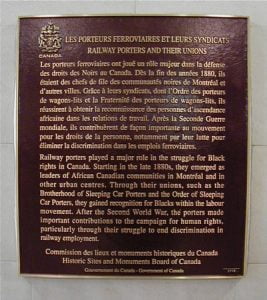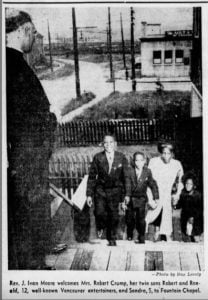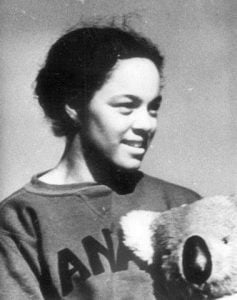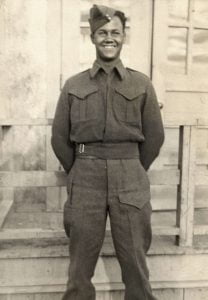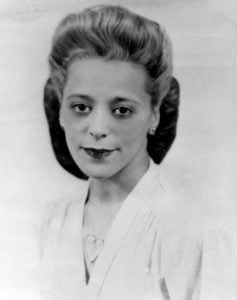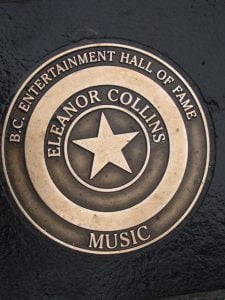BC Black History Timeline
John Freemont Smith was born in the Danish West Indies (now the Virgin Islands). He initially prospected in the Interior then spent some time in Victoria where he married and started a family. The family moved back to Kamloops where John owned and operated a retail business. In 1902 he became secretary of the Board of Trade. A year later he was elected alderman and served for four years. Various sources report that Smith served as the Indian Agent for the Kamloops Area from 1912 to 1923 and was instrumental in community organizations, including the Kamloops Agricultural Association, Rifle Association, Children’s Aid and Society for the Prevention of Cruelty of Animals.
Mifflin Wistar Gibbs was a prominent citizen of Victoria, serving as a councillor and co-owned the retail firm of Lester & Gibbs, a general store that was known for outfitting prospectors. He left Victoria in 1869 and became a municipal judge in Little Rock, Arkansas in 1873. His return visit was reported in the Colonist on August 31, 1907.“Pioneer of Victoria spends day in the city, Judge Gibbs of Little Rock Arkansas, here in the gold rush”. The article also reports “Mr. Gibbs owned five acres of land at the corner of Michigan and Menzies where he lived and where his five children were born..” This land, now Irving Park, is where the plaque is located honouring Gibbs as a “Person of National Historic Significance.”
Image of Gibbs, U.S. municipal judge, courtesy of Royal BC Museum and Archives

Moses Rowe Smith and family arrived in Victoria in 1858 from London, Ontario. His business interests included a bakery, biscuit factory, warehouse, confectionary shop, 14 delivery wagons and horses. In a special Victoria Colonist 50th anniversary edition is an article about the Smith business. The article reports on the history of the business and also notes twelve awards won locally and in London. Find out more
Around 1910 Black people began moving to Vancouver’s East Side neighbourhood of Strathcona, a mixed community of mainly Italian, Chinese and Black people. The Black people mostly settled in what became known as “Hogan’s Alley”. At its height in the 1930s and 1940s, the Black population numbered approximately 800. There were businesses, restaurants, and entertainment venues owned and operated by Black community members. The destruction of Hogan’s Alley starting in the 1950’s was part of a wave of “urban renewal” efforts across Canada and the U.S. that often targeted Black communities and their cultural enclaves.
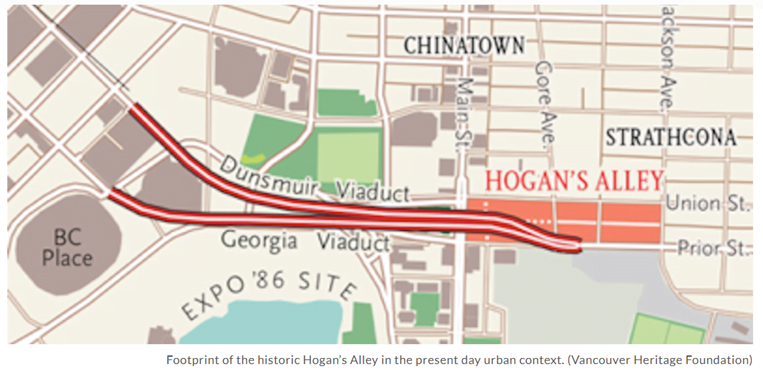
The Negro Christian Alliance (NCA) began to hear speakers, review papers, host discussions and debates, and provide opportunities for local talent to perform in the fall of 1910. The announcement for the first meeting stated, “All are cordially invited, regardless of colour or creed.” They organized and supported clubs and activities, including a Sunday School, for an estimated 150 youth. The NCA undertook a wide range of activities, such as debates on women’s suffrage. It also took a public stand for Prohibition. In December 1915 the NCA protested the movie “Birth of a Nation” as racist and dehumanizing.
On August 12, 1911, the Canadian government issued its infamous Order in Council to limit Black immigration to Canada. The purpose of the order was to ban Black persons from entering Canada for a period of one year, supposedly for the reason that “the Negro race … is deemed unsuitable to the climate and requirements of Canada.” Canadian Encyclopedia Order-in-Council P.C. 1911
Later policies also targeted Black immigrants. The West Indian Domestic Scheme induced approximately 3,000 Caribbean women to emigrate to Canada as domestic workers starting around 1955. The participants faced harsh work conditions and discrimination. The benefit to participants was devalued in January 1968 to provide only temporary work permits rather than landed immigrant status.
Henry Houston Scott, his wife Amy, and their three youngest children came from Oklahoma. The Scott’s settled in Surrey in 1912, purchasing a seven-acre parcel along today’s 64 Avenue at 181A Street. They were among the earliest Black families in that area. The family ran a farm, but all that remains today are some apple trees that still blossom. One son, Roy, worked at the local lumber mill and for Canadian Pacific Railway. Son Jesse worked as a dairy farmer and oil refinery worker and played baseball for the local team. Benola, the daughter and last surviving family member, died in 1971. A family grave stone was installed in 2018 by the City of Surrey.
Founded by Marcus Garvey in 1914, UNIA was part of a global movement to unite, empower, and improve the lives of people of African descent. The UNIA became one of the most successful Black organizations in world history. It had 1,000 divisions and claimed to have 6 million members in 40 countries with nearly 5000 members in Nova Scotia, Quebec, Ontario, Manitoba, Alberta, and British Columbia. In Canada, Garvey’s legacy remain. Marcus Garvey Day has been celebrated in some communities on 17 August since 1993.
In 2018 Canada designated the UNIA Movement “An Event of National Historic Significance”. The plaque is located at 2741 Notre-Dame Street West, Montréal, Quebec. Today, the Glace Bay, Nova Scotia UNIA Community Hall runs a cultural museum.
Many of the pioneers came to the British Colonies beginning in 1858 as young men and women and young families. It was their grandchildren and great-grandchildren who enlisted to fight for Canada in World War I and World War II. Hiram Whims was born in Tennessee and immigrated to Salt Spring c1859. Four grandsons served in World War I. Two great-grandsons served in World War II. We honour and remember those that served and continue to serve in times of war, conflict and peace
The movie “Birth of a Nation,” with its laudatory depiction of the KKK and distorted portrayal of Black people, was controversial wherever it went and banned globally in some countries, states and cities. Many historians, scholars and academics agree the movie is inaccurate and misrepresentative of Black people and of African American history. It has been condemned as racist and fueling xenophobia. On December 18, 1915, the movie was advertised as coming to the Avenue Theatre in Vancouver. On that same day, the NCA’s letter of disapproval to Vancouver City Council, “Negro Residents Protest,” was published in Vancouver Daily World Letters to the Editor. The NCA’s letter made a vehement and principled case that the movie “is a gross misrepresentation of the negro character and is calculated to stir up bad feeling against them, consequently we must deplore its being shown, especially at a time when the colored races of any Empire are doing so much to help us in the great war crises.”
Black men seeking to enlist for service in WWI were repeatedly turned away from military recruitment offices across Canada, but by 1916 the Allied leadership had become alarmed at the bloodbath that was taking place on European battlefields. The No. 2 Construction Battalion, the first and only Black battalion in Canadian military history, was authorized on July 5, 1916 with headquarters in Nova Scotia. “The Black Battalion 1916-1920 Canada’s Best Kept Military Secret” written by Senator Calvin W. Ruck is dedicated “To the memory of all Blacks who served in the Great War 1914 –1918” and relates their fight for equity in this country to the fight for this country.
Twelve men who were born in BC or were living in BC enlisted in the Battalion: Pte. Roy Alexander, Pte. Norman Bowden, Pte. Arthur Burns, Pte. Joseph Gilkes, Pte. Arnold William Harris, Pte. Ernest Hutcheson, Cpl. Daniel Livingstone, Pte. David Daniel Redman, Sapper James Douglas Whims, Pte. Robert Clark Whims, Pte. James Edward Wintworth, and Pte. Harry Wright.
The battalion was officially disbanded on September 15, 1920 …. with no formal recognition for their service until The National Apology was delivered by Prime Minister Justin Trudeau on July 9, 2022.
The Battle of Vimy Ridge took place on April 9, 1917. Pte. R. Gilbert, one of the few Black men permitted to enlist, (the 103rd Battalion recruited in, and was mobilized at Victoria, British Columbia) captured a German Officer who then gave Pte. Gilbert his own Iron Cross, because of the bravery and courage Gilbert showed in capturing the officer and 24 of his men! Find out more
Railway porters were hired from cities with established Black communities, including Vancouver’s Hogan’s Alley. The Canadian Museum for Human Rights states “porters tended to be highly educated men, with university degrees in science, medicine or business administration – prevailing racist attitudes held that Black people were socially inferior to whites and were meant to work in menial or subordinate vocations.” The porters’ union signed a collective bargaining agreement with the CPR in May 1945 after three years of intense negotiations.
Sleeping Car Porters in Canada
Historic Sites and Monuments Board of Canada plaque: Railway porters played a major role in the struggle for Black rights in Canada. Starting in the late 1880s, they emerged as leaders of African Canadian communities in Montréal and in other urban centres. Through their unions, such as the Brotherhood of Sleeping Car Porters and the Order of Sleeping Car Porters, they gained recognition for Blacks within the labour movement. After the Second World War, the porters made important contributions to the campaign for human rights, particularly through their struggle to end discrimination in railway employment. Designation Date: 1994-11-24
The location at the corner of Jackson and Prior Streets in Vancouver originally had a Lutheran Church that was constructed in 1904. The building was purchased in 1918 through the leadership of local resident Nora Hendrix and around 1921 opened as the African Methodist Episcopal Fountain Chapel. It was the spiritual and social heart of the community.
The first minister to serve was Reverend Ulysses S. Robinson, who arrived in Canada in October, 1921 (1888-1947). Reverend Robinson was the longest serving minister. The first Canadian-born minister was Reverend J. Ivan Moore. While today it is a private residence, it was designated as a Heritage Property by the City of Vancouver in 1994.
*Image: Rev. J. Ivan Moore welcomes Mrs. Robert Crump, her twin sons Robert and Ronald, 12, well-known Vancouver entertainers, and Sandra, 5, to Fountain Chapel. (1952) Photographer H.R. Lovely, Vancouver Daily Province
Barbara Howard was born and raised in Vancouver. She was the first Black woman athlete to represent Canada in an International event, competing at the 1938 British Empire Games held in Sydney, Australia from February 5 to 12. In 2012 she was inducted into the BC Sports Hall of Fame in the Pioneer Category.
Descendants of the Black pioneers who remained in BC enlisted to fight for Canada. Hiram Whims was born in Tennessee and immigrated to Salt Spring Island around 1859. Four grandsons served in World War I. Two great-grandsons served in World War II. We honour and remember the men and women who served and continue to serve in war, conflict and peace
Image: William “Billy” George Whims, was born on Salt Spring Island, the son of George Harim Whims. Billy was stationed in Petawawa, Ontario. Courtesy of Salt Spring Island Archives
In April 1941, Vancouver Newspapers began reporting on the “Crystal Pool Controversy”; where the Vancouver Parks Board imposed a colour ban limiting the use of the pool for Blacks and Chinese to only Tuesday mornings. While some Park Board members did protest, the “colour line” lasted for more than 4 years until November 1945.
Viola Desmond went to the Roseland Theatre in New Glasgow, Nova Scotia on November 8, 1946. She sat in a main floor seat and refused to move to the balcony, which was the only place Black patrons were permitted.
She was arrested, dragged out of the theatre, spent a night in jail, and charged with tax evasion for not paying the one-cent difference in the price of the main floor and balcony tickets. Desmond fought the case all the way to the Nova Scotia Supreme Court.
Although unsuccessful, her actions called attention to and helped end the practice of segregation. On November 19, 2018, Desmond became the first Canadian woman to appear alone on a Canadian bank note—a $10 bill. She was also named a National Historic Person in 2018.
On April 15, 1948, the Province newspaper reported that Mr. & Mrs. Dermont Cromwell received a letter demanding that they move from their home in southeast Vancouver, as they were not wanted in the neighbourhood. Auspiciously, Mr. Cromwell was the President of the Canadian Society for the Advancement of Colored People. Friends and neighbours rallied support for the couple. On May 21, 1948, Mrs. Margaret Kent was found guilty of threatening the couple and received a suspended sentence on posting a $1,000.00 peace bond.
Anti-Black racism remained prevalent in the province. In August 1948 Vancouver hotels refused accommodation to the Black cast of “Carmen,” and even 17 years later, in August 1965, professional Black football players were refused accommodation in some Vancouver hotels.
Barbara Howard wrote “I got my first job in Alberni from sending out resumes. It never occurred to me that people did not hire black teachers. About 10 years later, when I came back to Vancouver, I had no trouble getting work as a substitute teacher. So I waited every morning for that call at 7am to see if I’d have work that day.” At Strathcona School “I found out the P.E. teacher they had— a very fine teacher— was retiring, and they wanted to hire me full time. I stayed for eight years.” Barbara Howard on Life as an East Van P.E. Teacher
Image: “Barbara Howard is being inducted @BCSportsHall (2012) in the Pioneer category. She is a LEGEND!” by miss604 licensed with CC BY-NC-SA 2.0.
Dorothy Hewitt, of Jamaican ancestry, was married to a white teacher at Shawnigan Lake Boy’s School. She was told by Headmaster G. Peter Kaye to leave the school “before the boys come and see a coloured person here.” Her husband resigned, and they returned to Jamaica. Numerous articles were written about this case. Dorothy’s father, Noel Holtz, was the accountant general of the Jamaican government. The Jamaican House of Representatives sent protests to Canada.
Ray Baines, Colonist Legislative Reporter, frankly wrote in his column “Under The Dome,” “It doesn’t matter what words were used, who said them or how the discrimination was disguised. Strip away all the excess verbiage, explanations, and euphemisms like “mixed marriage” and what is left is racial discrimination.”
The very first Eleanor show aired on June 12, 1955. Eleanor Collins received numerous awards for her contribution to arts and entertainment, including the 1986 Centennial Distinguished Pioneer Award, induction into the BC Entertainment Hall of Fame (1992), ACTRA’s Sam Payne Lifetime Achievement Award, and lifetime achievement awards from the Toronto Black Diversity Network Black Canadian Award and the Black Women in Jazz Award. On November 21, 2014, on her 95th Birthday, Eleanor Collins was invested into the Order of Canada and in January 2022 honoured with a commemorative stamp.
Image courtesy of Judith Maxie
Edsworth Searles was the first Black lawyer called to the bar in BC. Canadian born, of British West Indian parents, Edsworth graduated from the University of Toronto with a Bachelor of Law. Following his short time in Vancouver, he returned to Toronto. In 1959 he was called to the Ontario bar.
The BC Association for the Advancement of Coloured People (BCAACP) was founded on March 1,1958 to support people facing discrimination in education, housing and the justice system; to lobby for human rights legislation in the provincial parliament; and to bring about curriculum changes in BC schools.
A 1971 survey reported on the geographic location and origins of Black residents; educational, employment and housing data; concepts of racial identity; and how Black people felt about the quality of Canadian citizenship. BCAACP remained active until the 1980’s.

